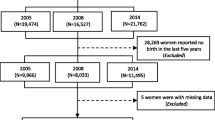Abstract
Objectives
To examine the most recent trends of cesarean delivery in Nepal and the association with socio-demographic characteristics of mothers.
Methods
Nationally representative cross-sectional data was used from three Demographic and Health Surveys conducted in Nepal in 2001 (N = 4,745), 2006 (N = 4,066) and 2011 (N = 4,148). Cesarean section delivery was measured in two categories with yes and no responses for the delivery in their latest pregnancy. Data on socio-demographic variables was obtained by interviewing the participants. The data was analysed using logistic regression models.
Results
The prevalence of cesarean section delivery was increased by more than 4 times from 2001 to 2011 both among rural and urban residents. After adjusting for mother’s age, number of births in last 5 years and mother’s education the prevalence of cesarean section delivery among all mothers was 1.71 times higher in 2006 (OR = 1.71, 95 % CI 1.23–2.37) and increased further in 2011 (OR = 2.42, 95 % CI 1.78–3.30) compared with year 2001. When adjusted for all the variables simultaneously, all variables except births in last 5 years remained significantly associated with cesarean section delivery of the mother. Older age, urban resident, being educated, having educated partners and being rich according to wealth index were associated with cesarean section delivery.
Conclusions
The prevalence of cesarean section delivery continues to rise but still lower than the World Health Organization recommended rates. More studies are needed to examine the non-medical reason of increasing rates of cesarean section deliveries and their effect in maternal and infant morbidity and mortality in Nepal.
Similar content being viewed by others
References
WHO (2010) Caesarean section without medical indication increases risk of short-term adverse outcomes for mothers. http://whqlibdoc.who.int/hq/2010/WHO_RHR_HRP_10.20_eng.pdf
WHO (1985) Appropriate technology for birth. Lancet 2:436–437
Gibbons L, Belizan JM, Lauer JA, Betran AP, Merialdi M, Althabe F (2012) Inequities in the use of cesarean section deliveries in the world. Am J Obstet Gynecol 206(331):e1–e19
Betrán AP, Merialdi M, Lauer JA, Bing-shun W, Thomas J, Van Look P et al (2007) Rates of caesarean section: analysis of global, regional and national estimates. Paediatr Perinat Epidemiol 21:98–113
Volpe FM (2011) Correlation of cesarean rates to maternal and infant mortality rates: an ecologic study of official international data. Pan Am J Public Health (Rev Panam Salud Pública) 29:303–308
Subedi S (2012) Rising rate of cesarean section: a year review. J Nobel Med Coll 2:72–76
Dobson R (2001) Caesarean section rate in England and Wales hits 21 %. Br Med J 323:951
Khawaja M, Kabakian-Khasholian T, Jurdi R (2004) Determinants of caesarean section in Egypt: evidence from the demographic and health survey. Health policy (Amsterdam, Netherlands) 69:273–281
Bogg L, Huang K, Long Q, Shen Y, Hemminki E (2010) Dramatic increase of cesarean deliveries in the midst of health reforms in rural China. Soc Sci Med 70:1544–1549
Wilkes P, Wolf D, Kronbach D, Kunze M, Gibbs R (2003) Risk factors for cesarean delivery at presentation of nulliparous patients in labor. Am J Obstet Gynecol 102:1352–1357
Flores PL, González PG, Trejo FJ, Vega LG, Cabrera PC, Campos A et al (2008) Risk factors in cesarean section (abstract). Ginecol Obstet Mex 76:392–397
Maharlouei N, Moalaee M, Ajdari S, Zarei M, Lankarani K (2013) Cesarean delivery in South-Western Iran: trends and determinants in a community-based survey. Med Princ Pract 22:184–188
Khawaja M, Nsour MA (2007) Trends in the prevalence and determinants of caesarean section delivery in Jordan: evidence from three demographic and health surveys, 1990–2002. World Health Popul 9:17–28
Klemetti R, Che X, Gao Y (2010) Cesarean section delivery among primiparous women in rural China: an emerging epidemic. Am J Obstet Gynecol 202:1–6
Mishra US, Ramanathan M (2002) Delivery-related complications and determinants of caesarean section rates in India. Health Policy Planning 17:90–98
Ford J, Grewal J, Mikolajczyk R, Meikle S, Zhang J (2008) Primary cesarean delivery among the parous women in the United States, 1990–2003. Obstet Gyenecol 112(1235):1241
Gossman GL, Joesch JM, Tanfer K (2006) Trends in maternal request cesarean delivery from 1991 to 2004. Obstet Gynecol 108:1506–1516
Conflict of interest
We declare that we have no conflict of interest.
Author information
Authors and Affiliations
Corresponding author
Rights and permissions
About this article
Cite this article
Prakash, K.C., Neupane, S. Cesarean deliveries among Nepalese mothers: changes over time 2001–2011 and determinants. Arch Gynecol Obstet 289, 421–427 (2014). https://doi.org/10.1007/s00404-013-2976-8
Received:
Accepted:
Published:
Issue Date:
DOI: https://doi.org/10.1007/s00404-013-2976-8




